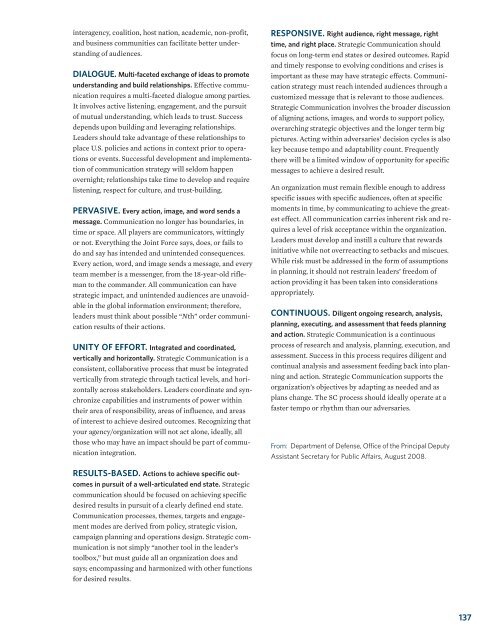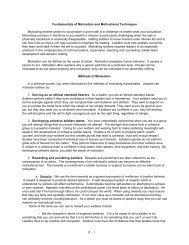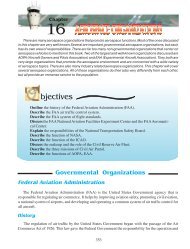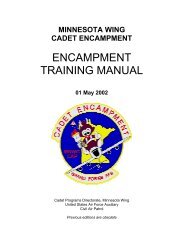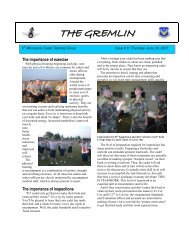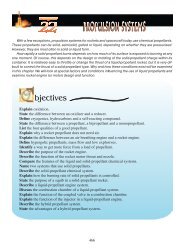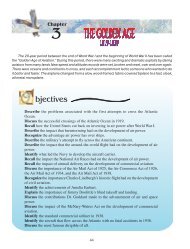16.1 Principles of Strategic CommunicationBy the Department of Defense, Office of the PDAS for Public AffairsOBJECTIVES:1. Define the term “strategic communication” and explain its relevance to leaders.2. List and describe the nine principles of strategic communication.Principle: A fundamental tenet; a determining characteristic;an essential quality; an enduring attribute.Strategic Communication (SC) has been described as theorchestration and/or synchronization of actions, images,and words to achieve a desired effect, yet there is more tounderstanding the concept.As the joint forces and agencies of the U.S. Governmenthave begun executing Strategic Communication processes,common fundamentals have emerged. Through the collaborativeefforts of DoD, State Department, civilian educators,and Strategic Communication practitioners, thosecommon fundamentals have been consolidated and refinedinto nine principles of SC, described below. These principlesare provided to assist dialogue and instruction promotingunderstanding of Strategic Communication.Shown below are nine principles of SC, with a shortdescription of each. A more detailed explanation of eachprinciple follows. The principles are not listed in anyorder of precedence.Leadership-DrivenLeaders must lead communication processCrediblePerception of truthfulness and respectDialogueMulti-faceted exchange of ideasUnity of EffortIntegrated and coordinatedResponsiveRight audience, message, time, and placeUnderstandingDeep comprehension of othersPervasiveEvery action sends a messageResults-BasedTied to desired end stateContinuousAnalysis, Planning, Execution, Assessment<strong>LEAD</strong>ERSHIP-DRIVEN. Leaders must decisivelyengage and drive the Strategic Communication process.To ensure integration of communication efforts, leadersshould place communication at the core of everythingthey do. Successful Strategic Communication – integratingactions, words, and images – begins with clear leadershipintent and guidance. Desired objectives andoutcomes are then closely tied to major lines of operationoutlined in the organization, command or join campaignplan. The results are actions and words linked to the plan.Leaders also need to properly resource strategic communicationat a priority comparable to other important areassuch as logistics and intelligence.CREDIBLE. Perception of truthfulness and respectbetween all parties. Credibility and consistency are thefoundation of effective communication; they build andrely on perceptions of accuracy, truthfulness, and respect.Actions, images, and words must be integrated and coordinatedinternally and externally with no perceivedinconsistencies between words and deeds or betweenpolicy and deeds. Strategic Communication also requiresa professional force of properly trained, educated, andattentive communicators. Credibility also often entailscommunicating through others who may be viewed asmore credible.UNDERSTANDING. Deep comprehension of attitudes,cultures, identities, behavior, history, perspectivesand social systems. What we say, do, or show may not bewhat others hear or see. An individual’s experience, culture,and knowledge provide the context shaping their perceptionsand therefore their judgment of actions. We mustunderstand that concepts of moral values are not absolute,but are relative to the individual’s societal and culturalnarrative. Audiences determine meaning by interpretationof our communication with them; thus what we say,do, or show may not be what they hear or see. Actingwithout understanding our audiences can lead to criticalmisunderstandings with serious consequences.Understanding subjective impacts of culture, language,history, religion, environment, and other factors is criticalwhen crafting communication strategy for a relevant population.Building relationship and collaboration with the136
interagency, coalition, host nation, academic, non-profit,and business communities can facilitate better understandingof audiences.DIALOGUE. Multi-faceted exchange of ideas to promoteunderstanding and build relationships. Effective communicationrequires a multi-faceted dialogue among parties.It involves active listening, engagement, and the pursuitof mutual understanding, which leads to trust. Successdepends upon building and leveraging relationships.Leaders should take advantage of these relationships toplace U.S. policies and actions in context prior to operationsor events. Successful development and implementationof communication strategy will seldom happenovernight; relationships take time to develop and requirelistening, respect for culture, and trust-building.PERVASIVE. Every action, image, and word sends amessage. Communication no longer has boundaries, intime or space. All players are communicators, wittinglyor not. Everything the Joint Force says, does, or fails todo and say has intended and unintended consequences.Every action, word, and image sends a message, and everyteam member is a messenger, from the 18-year-old riflemanto the commander. All communication can havestrategic impact, and unintended audiences are unavoidablein the global information environment; therefore,leaders must think about possible “Nth” order communicationresults of their actions.UNITY OF EFFORT. Integrated and coordinated,vertically and horizontally. Strategic Communication is aconsistent, collaborative process that must be integratedvertically from strategic through tactical levels, and horizontallyacross stakeholders. Leaders coordinate and synchronizecapabilities and instruments of power withintheir area of responsibility, areas of influence, and areasof interest to achieve desired outcomes. Recognizing thatyour agency/organization will not act alone, ideally, allthose who may have an impact should be part of communicationintegration.RESPONSIVE. Right audience, right message, righttime, and right place. Strategic Communication shouldfocus on long-term end states or desired outcomes. Rapidand timely response to evolving conditions and crises isimportant as these may have strategic effects. Communicationstrategy must reach intended audiences through acustomized message that is relevant to those audiences.Strategic Communication involves the broader discussionof aligning actions, images, and words to support policy,overarching strategic objectives and the longer term bigpictures. Acting within adversaries’ decision cycles is alsokey because tempo and adaptability count. Frequentlythere will be a limited window of opportunity for specificmessages to achieve a desired result.An organization must remain flexible enough to addressspecific issues with specific audiences, often at specificmoments in time, by communicating to achieve the greatesteffect. All communication carries inherent risk and requiresa level of risk acceptance within the organization.Leaders must develop and instill a culture that rewardsinitiative while not overreacting to setbacks and miscues.While risk must be addressed in the form of assumptionsin planning, it should not restrain leaders’ freedom ofaction providing it has been taken into considerationsappropriately.CONTINUOUS. Diligent ongoing research, analysis,planning, executing, and assessment that feeds planningand action. Strategic Communication is a continuousprocess of research and analysis, planning, execution, andassessment. Success in this process requires diligent andcontinual analysis and assessment feeding back into planningand action. Strategic Communication supports theorganization’s objectives by adapting as needed and asplans change. The SC process should ideally operate at afaster tempo or rhythm than our adversaries.From: Department of Defense, Office of the Principal DeputyAssistant Secretary for Public Affairs, August 2008.RESULTS-BASED. Actions to achieve specific outcomesin pursuit of a well-articulated end state. Strategiccommunication should be focused on achieving specificdesired results in pursuit of a clearly defined end state.Communication processes, themes, targets and engagementmodes are derived from policy, strategic vision,campaign planning and operations design. Strategic communicationis not simply “another tool in the leader’stoolbox,” but must guide all an organization does andsays; encompassing and harmonized with other functionsfor desired results.137
- Page 1 and 2:
VOLUME FOUR STRATEGIC PERSPECTIVESL
- Page 3 and 4:
VOLUME FOUR STRATEGIC PERSPECTIVESL
- Page 5 and 6:
VOLUME FOUR STRATEGIC PERSPECTIVESL
- Page 7:
VOLUME FOUR STRATEGIC PERSPECTIVESL
- Page 10 and 11:
12CHAPTER 12INTRODUCTION TO STRATEG
- Page 12 and 13:
12.1 Strategic Leadership: Defining
- Page 14 and 15:
mandates or resolutions that would
- Page 16 and 17:
and ambiguity, aspiring strategic l
- Page 18 and 19:
12.2 National Security StrategyThe
- Page 20 and 21:
within our borders has always been
- Page 22 and 23:
front common challenges like violen
- Page 24 and 25:
and our strategy, not sector earmar
- Page 26 and 27:
thinking about organizations. She m
- Page 28 and 29:
A systemic approach to failure is m
- Page 30 and 31:
The late W. T. Grant Company is a r
- Page 32 and 33:
the resources - setting the directi
- Page 34 and 35:
focal point for describing and inte
- Page 36 and 37:
Consequently, we do not restrict th
- Page 38 and 39:
paragraphs, Web pages, then edit an
- Page 40 and 41:
Web, can be viewed as a CS attempt
- Page 42 and 43:
How to evaluate users and contribut
- Page 44 and 45:
13CHAPTER 13LEADING PUBLIC &VOLUNTE
- Page 46 and 47:
13.1 Leadership for Volunteers:The
- Page 48 and 49:
13.2 Take Root: Volunteer Managemen
- Page 50 and 51:
QualificationsClearly list educatio
- Page 52 and 53:
and effectively track their volunte
- Page 54 and 55:
• Understand rules for recognitio
- Page 56 and 57:
• Send a birthday card.• Submit
- Page 58 and 59:
and tested more than six decades af
- Page 60 and 61:
specific interests of the donors, v
- Page 62 and 63:
tain) tax-exempt status from the In
- Page 64 and 65:
Smucker, 1999).The Internal Revenue
- Page 66 and 67:
culture is necessary to ensure the
- Page 68 and 69:
13.4 The New Look of TransparencyBy
- Page 70 and 71:
ees for a couple of reasons: One, i
- Page 72 and 73:
13.5 Public and Private Management:
- Page 74 and 75:
TABLE 1:FUNCTIONS OF GENERAL MANAGE
- Page 76 and 77:
3. Career System. The model corpora
- Page 78 and 79:
islative charter - the Clean Air Ac
- Page 80 and 81:
In controlling performance, Chapin
- Page 82 and 83:
14CHAPTER 14AIRPOWER ASSTRATEGIC LA
- Page 84 and 85:
14.1 Strategic Air Power: Fulfillme
- Page 86 and 87:
carry it out. Their daylight raids
- Page 88 and 89: you did not rely on strategic bombi
- Page 90 and 91: 14.2 Warden and the Air Corps Tacti
- Page 92 and 93: ecomes one of applying sufficient i
- Page 94 and 95: tification, and a Jominian claim to
- Page 96 and 97: courage the rapid and widespread ex
- Page 98 and 99: it to influence physical players in
- Page 100 and 101: 14.4 Basic Air Force DoctrineAF Doc
- Page 102 and 103: earthquake-stricken Haiti. The worl
- Page 104 and 105: perspective. Airmen do not divide u
- Page 106 and 107: Command and ControlCommand and cont
- Page 108 and 109: 14.5 Should the US Maintain the Nuc
- Page 110 and 111: form of human government.” 20 Dem
- Page 112 and 113: obtainable goal. See the Global Zer
- Page 114 and 115: 15CHAPTER 15ORGANIZATIONAL CULTURE
- Page 116 and 117: 15.1 Organizational CultureBy Doria
- Page 118 and 119: Review. This action strives to unco
- Page 120 and 121: gram will serve and then having the
- Page 122 and 123: ticipating the changes being made b
- Page 124 and 125: Many years of working with change p
- Page 126 and 127: At the least, the areas of concern
- Page 128 and 129: 15.4 Developing an Innovative Cultu
- Page 130 and 131: CONCLUDING THOUGHTSIn an ever-chang
- Page 132 and 133: global issues. Businesses that poss
- Page 134 and 135: — Sees the big picture—the shif
- Page 136 and 137: 16CHAPTER 16STRATEGIC COMMUNICATION
- Page 140 and 141: 16.2 The Art of NegotiationBy Brend
- Page 142 and 143: 16.3 Negotiating Effectively Across
- Page 144 and 145: hidden areas can act as cultural ho
- Page 146 and 147: and four conflict styles. Hammer be
- Page 148 and 149: maintaining the relationship. As th
- Page 150 and 151: 25 Mitchell R. Hammer, “Chapter 1
- Page 152 and 153: tural, socioeconomic, and psycholog
- Page 154 and 155: for the win-win," during which time
- Page 156 and 157: interests and, at worst, as a gun s
- Page 158 and 159: Public diplomacy is surely about mu
- Page 160 and 161: But public diplomats do not have th
- Page 162 and 163: Photo courtesy of the familyThe LEA
- Page 164: THE CADET OATHI pledge that I will


